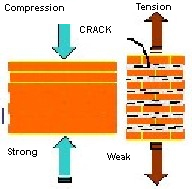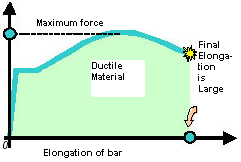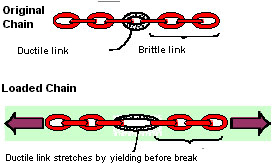|
HOW
TO
MAKE
BUILDING
FOR
GOOD
SEISMIC
PERFORMANCE? |
Construction Materials
|
In India, most non-urban buildings are made in masonry. In the
plains, masonry is generally made of burnt clay bricksand cement
mortar. However, in hilly areas, stone masonry with mud mortar
is more prevalent; but, in recent times, it is being replaced
with cement mortar. Masonry can carry loads that cause
compression (i.e., pressing together), but can hardly
take load that causes tension (i.e., pulling
apart) (Figure 1).
Concrete is another material that has been populary used in
building construction particulary over the last four
decades.Cement concrete is made of crushed stone
pieces (called
aggregate), sand, cement and water mixed in appropriate
proportions. Concrete is much stronger than masonry under
compressive loads, but again its behaviour in tension is
poor. The properties of concrete critically depend on the amount
of water used in making concrete; too much and too little water,
both can cause havoc. In general, both masonry and concrete are
brittle, and fail suddenly.
Steel is used in masonry and concrete building as reinforcement
bars of diameter and ranging from 6mm to 40 mm. |
 |
|
Figure 2: Masonry is strong in compression
but weak in tension. |
Reinforcing steel can
carry both tensile and compressive loads. Moreover, steel is a
ductile material. This important property of ductility enables
steel bars to undergo large elongation before breaking.
Concrete is used in buildings along with steel reinforcement
bars. This composite material is called reinforced cement
concrete or simply reinforced concrete (RC). The amount
and location of steel in a member should be such that the failure of
the member is by steel reaching its strength in tension before
concrete reaches its strength in compression. This type of failure
is ductile failure, and hence is preferred over a failure
where concrete fails first in compression. Therefore, contrary to
common thinking, providing too much steel in RC buildings can be
harmful even!!
|
Capacity Design Concept
Let us take two bars of same length and cross-sectional area -
one made of a ductile material and another of a brittle
material. Now, pull these two bars until they break!! You will
notice that the ductile bar elongates by a large amount before
it breaks, while the brittle bar breaks suddenly on reaching its
maximum strength at a relatively small elongation (Figure
2).Amongst the materials used in building construction, steel is
ductile, while masonry and concrete are brittle .
Now, let us make a chain with links made
of brittle and ductile materials (Figure 3). Each
of these links will fail just like the bars shown in Figure 2.
Now, hold the last link at either end of the chain and apply a
force F. Since the same force F is being
transferred through all the links, the force in each link is the
same, i.e., F. As more and more force is applied,
eventually the chain will break when the weakest link in
it breaks. If the ductile link is the weak one (i.e.,
its capacity to take load is less), then the chain will show
large final elongation. Instead, if the brittle link is the weak
one, then the chain will fail suddenly and show small final
elongation. Therefore, if we want to have such a ductile
chain, we have to make the ductile link to be the weakest
link.
|


|
| |
Figure 2:Tension
Test on Materials – ductile versus brittle materials. |
|
Let us take
two bars of same length and cross-sectional area - one made of a
ductile material and another of a brittle material. Now, pull
these two bars until they break!! You will notice that the
ductile bar elongates by a large amount before it breaks, while
the brittle bar breaks suddenly on reaching its maximum strength
at a relatively small elongation (Figure 2).Amongst the
materials used in building construction, steel is ductile,
while masonry and concrete are brittle .
Now, let us make a chain with links made
of brittle and ductile materials (Figure 3). Each
of these links will fail just like the bars shown in Figure 2.
Now, hold the last link at either end of the chain and apply a
force F. Since the same force F is being
transferred through all the links, the force in each link is the
same, i.e., F. As more and more force is applied,
eventually the chain will break when the weakest link in
it breaks. If the ductile link is the weak one (i.e.,
its capacity to take load is less), then the chain will show
large final elongation. Instead, if the brittle link is the weak
one, then the chain will fail suddenly and show small final
elongation. Therefore, if we want to have such a ductile
chain, we have to make the ductile link to be the weakest
link. |

Figure 3: Ductile chain design |
|
Earthquake-Resistant Design of Buildings
Buildings should be
designed like the ductile chain. For example, consider the
common urban residential apartment construction - the
multi-storey building made of reinforced concrete. It consists
of horizontal and vertical members, namely beams and
columns. The seismic inertia forces generated at its floor
levels are transferred through the various beams and
columns to the ground. The correct building components need
to be made ductile. The failure of a column can affect the
stability of the whole building, but the failure of a beam
causes localized effect. Therefore, it is better to make
beams to be the ductile weak links than columns. This
method of designing RC buildings is called the strong-column
weak-beam design method (Figure 4). |
 |
|
Figure
4: Reinforced Concrete Building Design:
the beams
must be the weakest links and not the columns – this can be
achieved by appropriately sizing the members and providing
correct amount of steel reinforcement in them. |
Quality Control in Construction
The capacity design concept in earthquake
resistant design of buildings will fail if the strengths of the
brittle links fall below their minimum assured values. The strength
of brittle construction materials, like masonry and concrete, is
highly sensitive to the quality of construction materials,
workmanship, supervision, and construction methods. Similarly,
special care is needed in construction to ensure that the elements
meant to be ductile are indeed provided with features that give
adequate ductility. Thus, strict adherence to prescribed standards
of construction materials and construction processes is essential in
assuring an earthquake-resistant building. Regular testing of
construction materials at qualified laboratories (at site or away),
periodic training of workmen at professional training houses, and
on-site evaluation of the technical work are elements of good
quality control.
Resource Material
Paulay,T., and Priestley,M.J.N., (1992),
Seismic Design of Reinforced Concrete Buildings and Masonry,
John Wiley, USA.
Mazzolani,F.M., and Piluso,V., (1996), Theory and Design of
Seismic-Resistant Steel Frames , E&FN Spon, UK.
Authored by:
C.V.R.
Murty
Indian Institute of Technology Kanpur, Kanpur, India
Sponsored by:
Building
Materials and Technology Promotion Council, New Delhi.
Suggestions/comments may be sent to
eqtips@iitk.ac.in
To see previous
IITK-BMTPC Earthquake Tips, visit
www.nicee.org
Back to Contents
|




